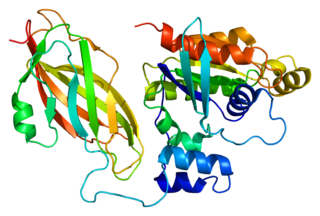Related Research Articles
GTPases are a large family of hydrolase enzymes that bind to the nucleotide guanosine triphosphate (GTP) and hydrolyze it to guanosine diphosphate (GDP). The GTP binding and hydrolysis takes place in the highly conserved P-loop "G domain", a protein domain common to many GTPases.
Small GTPases, also known as small G-proteins, are a family of hydrolase enzymes that can bind and hydrolyze guanosine triphosphate (GTP). They are a type of G-protein found in the cytosol that are homologous to the alpha subunit of heterotrimeric G-proteins, but unlike the alpha subunit of G proteins, a small GTPase can function independently as a hydrolase enzyme to bind to and hydrolyze a guanosine triphosphate (GTP) to form guanosine diphosphate (GDP). The best-known members are the Ras GTPases and hence they are sometimes called Ras subfamily GTPases.
GTPase-activating proteins or GTPase-accelerating proteins (GAPs) are a family of regulatory proteins whose members can bind to activated G proteins and stimulate their GTPase activity, with the result of terminating the signaling event. GAPs are also known as RGS protein, or RGS proteins, and these proteins are crucial in controlling the activity of G proteins. Regulation of G proteins is important because these proteins are involved in a variety of important cellular processes. The large G proteins, for example, are involved in transduction of signaling from the G protein-coupled receptor for a variety of signaling processes like hormonal signaling, and small G proteins are involved in processes like cellular trafficking and cell cycling. GAP's role in this function is to turn the G protein's activity off. In this sense, GAPs function is opposite to that of guanine nucleotide exchange factors (GEFs), which serve to enhance G protein signaling.

Guanine nucleotide exchange factors (GEFs) are proteins or protein domains that activate monomeric GTPases by stimulating the release of guanosine diphosphate (GDP) to allow binding of guanosine triphosphate (GTP). A variety of unrelated structural domains have been shown to exhibit guanine nucleotide exchange activity. Some GEFs can activate multiple GTPases while others are specific to a single GTPase.
The Rho family of GTPases is a family of small signaling G proteins, and is a subfamily of the Ras superfamily. The members of the Rho GTPase family have been shown to regulate many aspects of intracellular actin dynamics, and are found in all eukaryotic kingdoms, including yeasts and some plants. Three members of the family have been studied in detail: Cdc42, Rac1, and RhoA. All G proteins are "molecular switches", and Rho proteins play a role in organelle development, cytoskeletal dynamics, cell movement, and other common cellular functions.

Cell division control protein 42 homolog is a protein that in humans is encoded by the CDC42 gene. Cdc42 is involved in regulation of the cell cycle. It was originally identified in S. cerevisiae (yeast) as a mediator of cell division, and is now known to influence a variety of signaling events and cellular processes in a variety of organisms from yeast to mammals.

FYVE, RhoGEF and PH domain-containing protein 1 (FGD1) also known as faciogenital dysplasia 1 protein (FGDY), zinc finger FYVE domain-containing protein 3 (ZFYVE3), or Rho/Rac guanine nucleotide exchange factor FGD1 is a protein that in humans is encoded by the FGD1 gene that lies on the X chromosome. Orthologs of the FGD1 gene are found in dog, cow, mouse, rat, and zebrafish, and also budding yeast and C. elegans. It is a member of the FYVE, RhoGEF and PH domain containing family.

Transforming protein RhoA, also known as Ras homolog family member A (RhoA), is a small GTPase protein in the Rho family of GTPases that in humans is encoded by the RHOA gene. While the effects of RhoA activity are not all well known, it is primarily associated with cytoskeleton regulation, mostly actin stress fibers formation and actomyosin contractility. It acts upon several effectors. Among them, ROCK1 and DIAPH1 are the best described. RhoA, and the other Rho GTPases, are part of a larger family of related proteins known as the Ras superfamily, a family of proteins involved in the regulation and timing of cell division. RhoA is one of the oldest Rho GTPases, with homologues present in the genomes since 1.5 billion years. As a consequence, RhoA is somehow involved in many cellular processes which emerged throughout evolution. RhoA specifically is regarded as a prominent regulatory factor in other functions such as the regulation of cytoskeletal dynamics, transcription, cell cycle progression and cell transformation.

Rac2 is a small signaling G protein, and is a member of the Rac subfamily of the family Rho family of GTPases. It is encoded by the gene RAC2.

RhoG is a small monomeric GTP-binding protein, and is an important component of many intracellular signalling pathways. It is a member of the Rac subfamily of the Rho family of small G proteins and is encoded by the gene RHOG.

Rnd1 is a small signaling G protein, and is a member of the Rnd subgroup of the Rho family of GTPases. It is encoded by the gene RND1.

Rnd3 is a small signaling G protein, and is a member of the Rnd subgroup of the Rho family of GTPases. It is encoded by the gene RND3.

Dedicator of cytokinesis protein (Dock7) is a large protein encoded in the human by the DOCK7 gene, involved in intracellular signalling networks. It is a member of the DOCK-C subfamily of the DOCK family of guanine nucleotide exchange factors (GEFs) which function as activators of small G-proteins. Dock7 activates isoforms of the small G protein Rac.
TCL is a small signaling G protein, and is a member of the Rho family of GTPases.
Rif is a small signaling G protein, and is a member of the Rho family of GTPases. It is primarily active in the brain and plays a physiological role in the formation of neuronal dendritic spine. This process is regulated by FARP1, a type of activator for RhoA GTPases. Alternatively, Rif can induce the formation of actin stress fibers in epithelial cells, which is dependent on the activity levels of ROCK proteins since the absence of ROCK activity would mean Rif would be unable to stimulate the growth of stress fibers.

Dedicator of cytokinesis protein 4 (Dock4), is a large protein encoded in the human by the DOCK4 gene, involved in intracellular signalling networks. It is a member of the DOCK-B subfamily of the DOCK family of guanine nucleotide exchange factors (GEFs) which function as activators of small G-proteins. Dock4 activates the small G proteins Rac and Rap1.

Dedicator of cytokinesis protein 11 (Dock11), also known as Zizimin2, is a large protein encoded in the human by the DOCK11 gene, involved in intracellular signalling networks. It is a member of the DOCK-D subfamily of the DOCK family of guanine nucleotide exchange factors (GEFs) which function as activators of small G-proteins. Dock11 activates the small G protein Cdc42.

Clostridioides difficile toxin A (TcdA) is a toxin produced by the bacteria Clostridioides difficile, formerly known as Clostridium difficile. It is similar to Clostridium difficile Toxin B. The toxins are the main virulence factors produced by the gram positive, anaerobic, Clostridioides difficile bacteria. The toxins function by damaging the intestinal mucosa and cause the symptoms of C. difficile infection, including pseudomembranous colitis.

Alan Hall FRS was a British cell biologist and a biology professor at the Sloan-Kettering Institute, where he was chair of the Cell Biology program. Hall was elected a Fellow of the Royal Society in 1999.

Pleckstrin homology domain containing, family G member 2 (PLEKHG2) is a protein that in humans is encoded by the PLEKHG2 gene. It is sometimes written as ARHGEF42, FLJ00018.
References
- ↑ Ridley AJ (October 2006). "Rho GTPases and actin dynamics in membrane protrusions and vesicle trafficking". Trends in Cell Biology. 16 (10): 522–529. doi:10.1016/j.tcb.2006.08.006. PMID 16949823.
- ↑ "Rac", Encyclopedia of Cancer, Springer Berlin Heidelberg, 2011, p. 3133, doi:10.1007/978-3-642-16483-5_4891, ISBN 9783642164828
- 1 2 Pantarelli C, Welch HC (November 2018). "Rac-GTPases and Rac-GEFs in neutrophil adhesion, migration and recruitment". European Journal of Clinical Investigation. 48 Suppl 2 (Suppl Suppl 2): e12939. doi:10.1111/eci.12939. PMC 6321979 . PMID 29682742.
- ↑ Sun D, Xu D, Zhang B (December 2006). "Rac signaling in tumorigenesis and as target for anticancer drug development". Drug Resistance Updates. 9 (6): 274–287. doi:10.1016/j.drup.2006.12.001. PMID 17234445.
- ↑ Shuai Y, Lu B, Hu Y, Wang L, Sun K, Zhong Y (February 2010). "Forgetting is regulated through Rac activity in Drosophila". Cell. 140 (4): 579–589. doi: 10.1016/j.cell.2009.12.044 . PMID 20178749.
- ↑ "Brain memory is actively cleared". scitechstory.com. Archived from the original on 2012-12-19.
- ↑ Bar-Sagi, Dafna; Hall, Alan (2010). "Ras and Rho GTPases". Cell. 103 (2): 227–238. doi: 10.1016/S0092-8674(00)00115-X . PMID 11057896. S2CID 14521188.